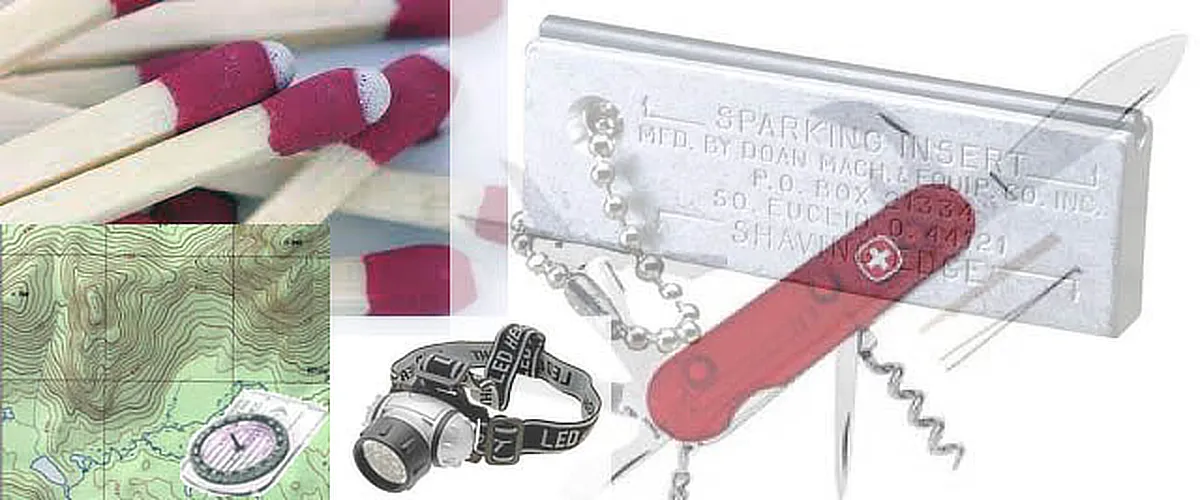Survival Items List Of 10 Essentials For A Kit

A simple but essential survival items list for a basic kit. Here are 10 survival items you might choose as a minimum to start any survival emergency kit. Then, you could build up the list and tailor the kit from there depending on the specific purpose of the kit, your personal preferences, needs, methods of carry, etc.
When making your own survival kit items list and deciding what to include, first think about where and how you might use the item or its purpose as it relates to your activity.
Is it for your car? In your backpack on a day hike? A week-long camping trip? A bug-out bag with 72-hour provisions? This will change what you might choose to include.
Also, think about the resources that may already be available in the area where you plan to be or where you might be using your kit. Again, this will affect the decisions that you make about what to include in the kit.
The following survival kit list of items is intended to present ideas to spark your own thoughts:
I may earn commission (no extra cost) if purchased.
Thank you
Survival Items Kit List Of Basics
Ways To Make Fire
Every single survival kit list should include a means to make fire.
The Magnesium fire starter is a very popular survival kit item. Be sure to practice with it after you buy one!
[ Read: Doan Magnesium Fire Starter ]
A FireSteel is an awesome little gadget that generates copious sparks when scraped (e.g., with a knife).
[ Read: FireSteel Rod For Survival ]
‘Strike Anywhere’ matches. Store them in a watertight case or bag, and consider including a ‘striker,’ perhaps an emery board, or women’s nail file.
Keeping an ordinary BIC lighter in addition to matches is a good idea, too.
Could you build and add a mini fire kit and Tinder to build a fire?
[ Read: A Fire Starter Kit List ]
[ Read: List Of Source Materials For Tinder ]
Knife
What survival items list isn’t complete without a knife?!
You should include a fixed-blade knife or a cutting tool of some sort. A pocket knife suits your needs well enough, or a multi-purpose tool with a knife might be helpful.
I personally like the fixed-blade style knife (and sheath) more for its size, blade options, strength, and multipurpose uses than an ordinary pocket knife. However, I always carry a pocket knife.
There are many knife makes, models, and manufacturers to choose from. Choosing a knife can become overwhelming. It is a personal choice.
Consider sticking with name brands, such as Morakniv, CRKT, Gerber, Buck, SOG, Spyderco, Kershaw, and other familiar names.
[ Read: The Best Knife For Batoning Wood ]
Maps & Compass
Do you know where you’re going? Can you get somewhere you’ve never been before? Can you navigate there without a GPS?
Keep a hard-copy map of the region you’re in. If you’re off-road, keep a topo (topographical) map; if you’re on the road, keep a road map or both.
Know how to read and navigate with maps. The basics are simple. A compass, complementary to the map, will establish bearings.
[ Read: A Good Compass ]
[ Read: Road Atlas List – All States ]
Cordage, Paracord
Cordage. There are lots of choices. Paracord is one of several types of cord that I like.
Keep a length of ‘550 Paracord’ (or another cord of your choosing). A minimum of 10-20 feet seems reasonable for starters and most ordinary uses (lashing, etc.). If space permits, I prefer to keep a bit more than that in a general-purpose survival kit.
While the ‘550 Paracord’ is a good old standby, the newer 750lb cord is a great choice.
[ Read: Five Benefits Of Paracord ]
Flashlight, extra batteries
A survival kit list without a flashlight?? That would be unheard of…
LED flashlight and/or headlamp. An ideal choice is an LED flashlight, preferably a head-mounted style (for hands-free).
Keep an extra set of batteries!
I recently purchased the following Streamlight flashlight for a travel bag that I put together. It is compact, 350-lumens, and will accept CR123A lithium or AA batteries (I like the dual battery type choice).
[ Read: Headlamp or Flashlight ]
Food
A food bar is a good, easy choice for a basic survival kit. Calorie-dense food bars are convenient for short-duration kits.
One of my favorites is the CLIF Bar because it tastes good and is more calorie-dense than many others. Your chosen quantity, food type, and packaging will likely depend upon the kit’s purpose (day pack, overnight backpacking, vehicle kit, etc.).
MREs are another consideration for survival kit food. There are lots of practical choices in this category…
[ Read: The CLIF Bar Is A Great Choice For Your Survival Kit ]
First Aid Kit
You might not think you’ll ever need it, but having a basic compact mini first aid kit within one’s general-purpose survival kit is a good idea.
I typically build my own mini first aid kit for a basic survival kit.
One particular small first aid kit (tin) that contains at least the most commonly used items (which you could add to) is the following Coleman mini first aid kit:
[ Read: A Small Do It Yourself First Aid Kit ]
Mylar Emergency Blanket
A Mylar ‘space blanket’ or emergency blanket will serve multiple purposes, including warmth (you can wrap yourself in it to reflect your body heat back to you) and potential shelter similar to a small tarp.
They fold up reasonably small, so keeping several will hardly take any room in your kit. I like an emergency blanket that is better than the typical thin type. The following are two examples of great choices…
[ Read: Uses For A Space Blanket – Emergency Blanket ]
Stainless Steel Water Container
You can bring water with you, and if you get the right kind of water container, it will also serve as a vessel to boil water for safe drinking from questionable water sources.
Consider the kind with a screw-on lid, purposely made for hiking. If you might ever use it to boil water, get the single-walled type and one that’s not painted (get stainless steel).
Drinking Water Filter
Since we’re talking about water, a portable drinking water filter is advisable, too. The LifeStraw or the Sawyer Mini are both great choices for a survival kit (and not expensive).
[ Read: Review of the Sawyer Mini ]
[ Read: LifeStraw – 10 Benefits – And The Newer ‘LifeStraw Go’ ]
SUMMARY
Note: There are LOTS more items to consider for a basic (general-purpose) emergency kit.
This survival items list is meant to give you ideas as a starting point for putting together your own kit.
These items will easily fit into a backpack. You can adjust the contents as you see fit, as any such list is variable depending on what you use and what you prefer.
[ Read: The 10 C’s Of Survivability ]
Among the highest priorities for survival is safe drinking water.
AlexaPure Pro Gravity-Powered Water Filtration
Tested against NSF/ANSI 53, NSF/ANSI 42

